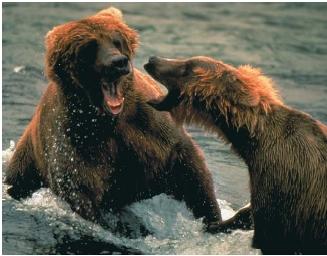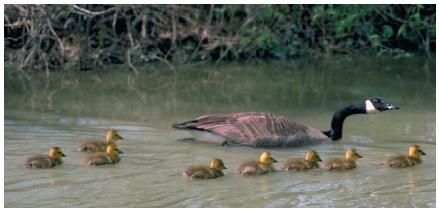Behavior

Behavior is the way that all organisms or living things respond to stimuli in their environment. Stimuli include chemicals, heat, light, touch, and gravity. For example, plants respond with growth behavior when light strikes their leaves. Behavior can be categorized as either instinctive (present in a living thing from birth) or learned (resulting from experience). The distinction between the two is often unclear, however, since learned behavior often includes instinctive elements. Plants and animals that lack a well-developed nervous system rely on instinctive behavior. Higherdeveloped animals use both instinctive and learned behavior. Generally, behavior helps organisms survive.
Plant behavior
The instinctive behavior of a plant depends mainly on growth or movement in a given direction due to changes in its environment. The growth or movement of a plant toward or away from an external stimulus is known as tropism. Positive tropism is growth toward a stimulus, while negative tropism is growth away from a stimulus. Tropisms are labeled according to the stimulus involved, such as phototropism (light) and gravitropism (gravity). Plants growing toward the direction of light exhibit positive phototropism. Since roots grow downward (with gravity),
Words to Know
Ethology: The scientific study of animal behavior under natural conditions.
Operant conditioning: Trial-and-error learning in which a random behavior is rewarded and subsequently retained.
Stimulus: Something that causes a behavioral response.
Tropism: The growth or movement of a plant toward or away from a stimulus.

they exhibit positive gravitropism. Stems of plants grow upward (against gravity), exhibiting negative gravitropism.
Animal behavior
The scientific study of animal behavior under natural conditions, known as ethology, focuses on both instinctual and learned behavior. Ethologists look at an animal's environment to see how events in that environment combine with an animal's instincts to shape overall behavior. This is especially important in the developing or early stages of an animal's life.
Animals exhibit various levels of instinctual behavior. On a elementary level are reflexes. A reflex is a simple, inborn, automatic response of a part of the body to a stimulus. Reflexes help animals respond quickly to a stimulus, thus protecting them from harm. Other instinctual behaviors are more complex. Examples of this kind include the nest-building behavior of birds and the dam-building behavior of beavers.
Imprinting. An example of animal behavior that combines instinct and learning is imprinting, often seen in birds such as geese and ducks. Within a short, genetically set time frame an animal learns to recognize and then bond to its parent, helping it to survive its infancy. Newly hatched geese or goslings are able to walk at birth. They quickly learn to recognize the movements of their parents and then follow them. If the parents are removed within the first few days after birth and are replaced by

any moving object, the goslings imprint or bond to that object, learning to follow it.
Animals often add to their set of instinctual behaviors through trial-and-error learning, known as operant conditioning. Young chimps, for example, watch their parents strip a twig and then use the prepared stick to pick up termites from rotten logs. When the young chimps repeat this procedure, their behavior is rewarded by the meal of termites, a preferred food. This reward teaches the chimps to repeat the same behavior when next hungry.
Courtship behaviors. There are many kinds of interactive behavior between animals. One of them is courtship behavior, which enables an animal to find, identify, attract, and arouse a mate. During courtship, animals use rituals, a series of behaviors performed the same way by all the males or females in a species. These include leaping and dancing, singing, the ruffling of feathers, or the puffing up of pouches. The male peacock displays his glorious plumage to the female. Humpback whales announce their presence under the sea by singing a song that can be heard hundreds of miles away.
Group behaviors. Some animals live together in groups and display social behavior. The group protects its members from predators, and allows cooperation and division of labor. Insects, such as bees, ants, and termites, live in complex groups in which some members find food, some defend the colony, and some tend to the offspring. Hierarchies or ranking systems help reduce fighting in a group. Chickens, for example, have a peck-order from the dominant to the most submissive. Each chicken knows its place in the peck-order and does not challenge chickens of higher rank, thereby reducing the chances of fighting. Interactions among group members get more complex with more intelligent species such as apes.
[ See also Brain ; Nervous system ]